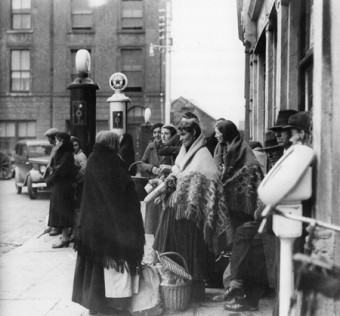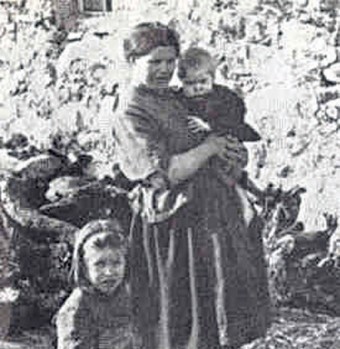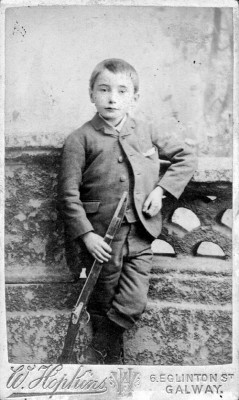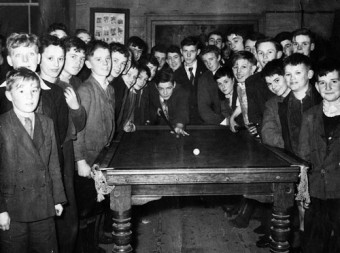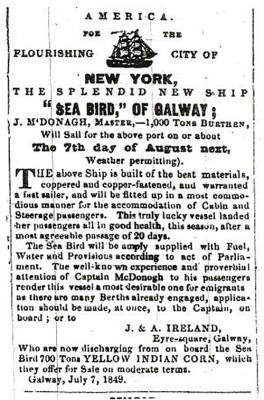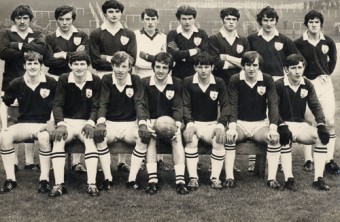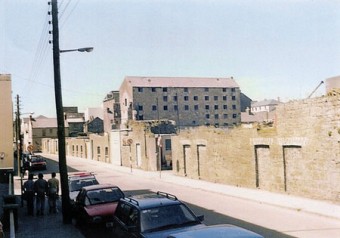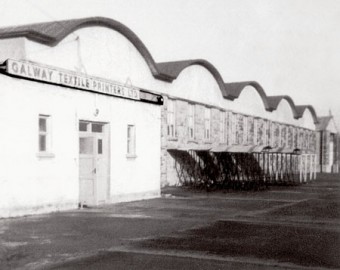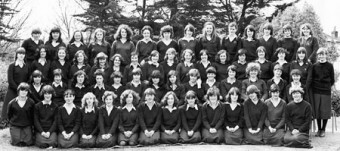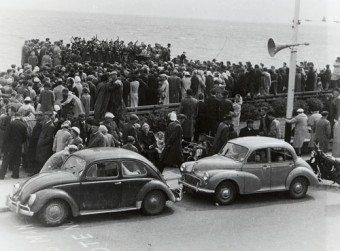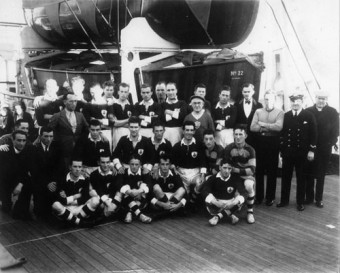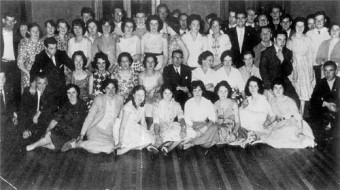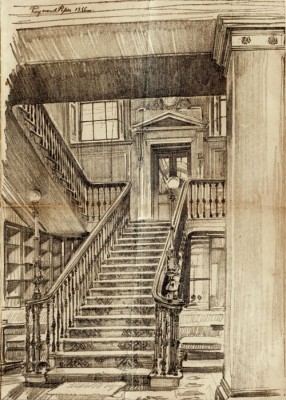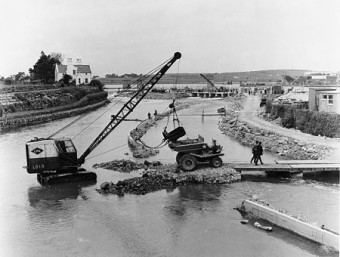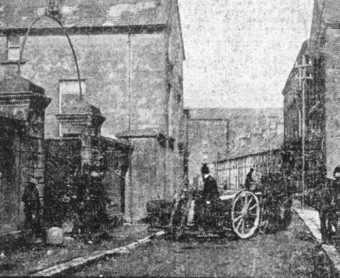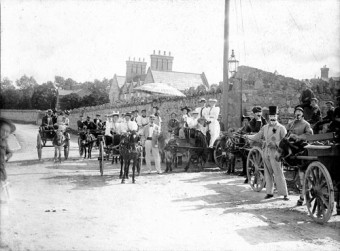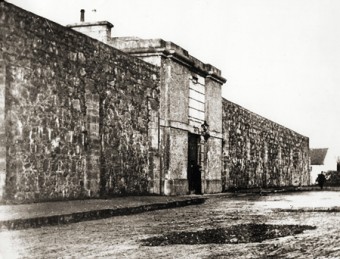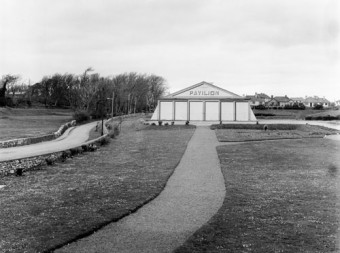Changing fashions, Eyre Square
Thu, Jul 07, 2011
There is a wonderful mix of the modern and the traditional in this photograph which was taken at the corner of Eyre Square and Rosemary Avenue in the mid 1930s. The woman in the foreground is wearing a plain black shawl, a petticoat and a ‘práiscín’ which was a heavy canvas apron worn to protect the skirt. Two others are wearing beautifully patterned shawls which must have looked very elegant and colourful. They had probably come into town to sell their wares, and then went shopping with the proceeds, and their baskets are now full. The other women in the picture are all dressed in more ‘up to date’ coats and berets. It looks as if all of these people are waiting for a bus.
Read more ...Attempts made in 1847 to establish fishing industry in the west
Thu, Jul 07, 2011
The tragedy of the Great Famine was compounded by the fact that our seas were full of fish, yet the lack of a sustainable fishing industry, and a general dislike of fish among the peasantry, left untouched this abundant food source. As the appalling statistics of hunger, riots, death, fever and evictions began to penetrate the British government, some action was at last taken*. Unsuitable as it was for Irish palates, vast quantities of American maize was imported, and distributed. Public relief schemes, such as canal-building and new roads were introduced to provide some employment, and efforts were made to establish a fishing industry.
Read more ...Pádraic Ó Conaire, prince of storytellers
Thu, Jun 30, 2011
“A short walk on the gravelled path and I was before the man I had come to see. There was a great peace about him as he sat there, leg crossed upon leg, hat rakish on his head, mute in the sculptured dignity of stone. Ever since I had learned the Gaelic, I had loved him, this strange man of dreams whose friends were the birds and the furry people of the wood, the wind and the small white stars.
Read more ...Our Lady’s Boys’ Club, a Galway gem
Thu, Jun 23, 2011
This photo of a happy group of Boys Club lads was taken in the mid fifties and includes Paddy O’Connell, Dominick Curran, Seanie Flaherty, Joe Walsh, --- Harty, Tommy Gannon, Dessy Fitzpatrick, Michael Burke, Tom Cunningham, Bartley Hynes, Tony Conboy (taking the shot), Sean McNamara, Gerry Ryan, Willie Golding, Colie Rushe, William McDonagh, Peter Folan, Leo Creane, Francis Walsh, Danny Collins, Jackie Molloy, Dominick Geary, and Paddy McDonagh.
Read more ...The Great Famine in Galway
Thu, Jun 16, 2011
Like most towns in Ireland, Galway was used to food shortages; they had occurred here in 1816, 1817, 1822, 1831, and in 1842 there were food riots in the city. Nobody, however, was prepared for what happened in 1845 when the potato crop failed. As winter approached, the situation did not seem any worse than usual, though people were concerned about food being exported from the docks while there was a shortage locally.
Read more ...Galway minors, All Ireland champions 1970
Thu, Jun 09, 2011
Now that Alan Mulholland’s under-21 team have kickstarted the Galway GAA season in such spectacular fashion, we thought to show you some champions of yesteryear, the county minor team who won the All Ireland in 1970.
Read more ...Merchants Road, after the fire
Thu, May 26, 2011
This photograph was taken in the late seventies, and shows how quickly streetscapes can change. Merchants Road was originally known as ‘Back Street’ because it was at the back of (outside) the old city walls. As the docks were developed, a lot of warehousing and industrial buildings were constructed around the area to facilitate companies who were importing and exporting from the port, and so Merchants Road came into being. It was a drab street, quite a bit of the area we see in the foreground was warehousing, like the tall building we see in the centre of our picture.
Read more ...Galway Textile Printers
Thu, May 12, 2011
Our photograph today, which is courtesy of Pat McPhilbin from Emmett Avenue in Mervue, shows a large factory building which was constructed by Sisk’s (with Jack Lillis in charge) on a site on Sandy Road in the early fifties. It was to house an industry called Galway Textile Printers which was known locally as ‘The Cotton Factory’, and even more colloquially as ‘The Cotton’. There already was a hat factory and a china factory here, but GTP was the first major industry to come to Galway and quickly became one of the biggest employers in the west of Ireland. Some of those who worked there were specialists who were brought in to help set the factory up, but most employees were local.
Read more ...Calling all Salerno past pupils
Thu, May 05, 2011
Bishop Browne invited the Sisters of Jesus and Mary to open a national school in Salthill, and on May 1 1952 Scoil Íde opened in what used to be a small hotel called Dalysfort House, with 43 pupils and three teachers. The numbers grew rapidly, so it was decided to knock the old hotel and build a new school. This was officially opened by the minister for education, Dr Patrick Hillery, in 1962.
Read more ...Currach racing in Salthill in the 1950s
Thu, Apr 28, 2011
In the early 1950s a group of people got together to come up with ideas for extending the tourist season. They decided to focus on traditional Irish cultural events throughout the country, often with a local flavour, and they called the project An Tóstal. A committee was set up in Galway and they came up with the concept of an All-Ireland Currach Racing Championships. Nothing like this had ever been done before, so it took quite a bit of organisation.
Read more ...The men who first brought Sam to Galway
Thu, Apr 14, 2011
Galway reached the All-Ireland football final for the first time in 1919, when they were beaten by Kildare by 2 – 5 to 0 – 1. In 1922 they were beaten by Dublin by 6 points to 4. In 1925 they won it for the first time, beating Cavan by 3 – 2 to 1 - 2. In 1928, the Sam Maguire Trophy was presented to the GAA, and ever since, it has been the dream of every county in Ireland to hold it aloft in Croke Park on the third Sunday in September.
Read more ...Thanks for the memories
Thu, Mar 31, 2011
Seapoint Ballroom was officially opened at 10pm on July 17 1949 by Joe Costelloe, Mayor of Galway. Noel Finan bought the site from Jim and Mary Cremin, who were brother and sister. They ran a famous seawater baths there, a kind of health spa of its day. At the time Salthill was a small village with a few hotels, B&Bs, and shops. It also had the Hangar which was run by John Allen, but it closed down in Race Week when dancing moved into a marquee in Eyre Square. At the time it was 1s 6d into the Hangar for women and 1s 9d for men.
Read more ...A relic of old world charm
Thu, Mar 24, 2011
Our image today is of an original drawing done in 1958 by Belfast artist Raymond Piper (now deceased) of the beautiful staircase in the Great Southern Hotel. When one entered the hotel, the reception desk was to the left, there was a small corridor leading to the dining room on the left, and another leading to the bar on the right. Just past these was a comfortable lounge area, and at the end of this was this magnificent staircase leading to reception rooms upstairs, and directly to the station platform.
Read more ...Dredging the river
Wed, Mar 16, 2011
Alexander Nimmo made a survey of Lough Corrib almost 200 years ago in which he wrote the following: “The lake has 50 miles of shore, occupies 30,000 Irish acres and contains 1,000 acres of arable land in its isles, and contracts into a very spacious river about two and a half miles above Galway, which, flowing by the town, communicated with the Atlantic. The fall from the summit lake to the sea is considerable, but to the Wood Quay, above the town, it is trifling, and the river is in parts very shallow, running over a bed of rocks and hard gravel. It is not navigable from the sea to the Wood Quay, owing to the shallowness and rapidity of the water, and none but small boats can come down; but, unless in very dry seasons, it is thence navigable by boats drawing four feet of water and carrying from ten to twenty tons, with one square sail and four men, to Cong. They seldom sail unless before the wind, and though the lake has many islets and sunken rocks, the only serious difficulty in navigation is at Buachally Shoal about four miles up the lake, and at Newcastle. These shoals could be deepened for a small sum and the whole made to admit vessels of much greater magnitude. This fine navigation which extends about 30 miles, and into a seaport town, seems to deserve more attention than it has yet received. A good chart with soundings and sailing directions, should be published, the shoals or rocks cleared or beaconed, and a communication opened with the sea.”
Read more ...Nuns Island about one hundred years ago
Thu, Mar 10, 2011
In the 19th century Nuns Island was part of the industrial heartland of Galway. The 1911 census tells us that the street comprised two lodging houses, Grace’s Asylum, the Presbyterian Church, a ladies’ school, a fever hospital, Her Majesty’s Prison, a brewery and malt house, St Joseph’s Seminary, two flour mills, a granite works, and the Poor Clares Convent as well as the various residences.
Read more ...Howsa goan luveen…
Thu, Feb 24, 2011
“Arrah, howsa goan luveen.”
“Musha, not too bayad dontcha no, how’s yersel?”
“Musha, not too bayad dontcha no, how’s yersel?”
Read more ...Galway Workhouse
Thu, Feb 17, 2011
The ‘Night of The Big Wind’ on the night of January 6/7, 1839, deprived thousands of people in the Galway area of their homes. Their situation in the depths of winter was more than local charities could cope with. On May 8, the Galway Union was proclaimed to include the city and surrounding townlands to a radius of roughly 10 miles plus the Aran Islands, all of which would be served by a single workhouse in Galway. The first meeting of the Galway Board of Guardians was held in the Courthouse on July 3 of that year.
Read more ...The Garra Glas in the Claddagh
Thu, Feb 10, 2011
The Garra Glas (The green field or green garden) was an area of the Claddagh which corresponds to where the Fire Station is today. Our photograph was taken in the 1930s when things were changing in the area .. the old Claddagh houses were being gradually knocked down to make way for those that are there today. Kerbstones were being laid down to frame the newly laid road surface. The house we see on the left belonged to the Flaherty family. The building next to it was obviously converted from a cottage into a workshop of some kind with the large beam supporting the double doors. Next door was Cubbards. You can see someone peeping out the door.
The gap between it and the next house led down to Raftery's Woollen Mills, which was probably the only manufacturing business in the Claddagh. There were spinners and woollen carders who made black mourning shawls among other things.
Read more ...Executions in Galway Gaol
Thu, Feb 03, 2011
This photograph of the main entrance to Galway Gaol (facing the Salmon Weir Bridge) was taken in 1903. It was an imposing and intimidating building. The execution chamber was just over the main gate, and many prisoners perished there.
Read more ...Memories of the Hangar
Thu, Jan 27, 2011
What we know as Salthill Park was originally a large field with a small lake. It was landscaped in 1907. In 1925 the Salthill Development Organisation (SDO) asked the corporation to clean up a cesspool there, but that took some years. In 1924, three councillors, Mr Bailey, Eyre Square, Martin Cooke, and John Coogan, bought an aeroplane hangar for the urban council for £400. It had been used by the RAF in Oranmore and was re-erected it in the park. It was called the Pavilion Ballroom, but everyone knew it as ‘the Hangar’.
Read more ...